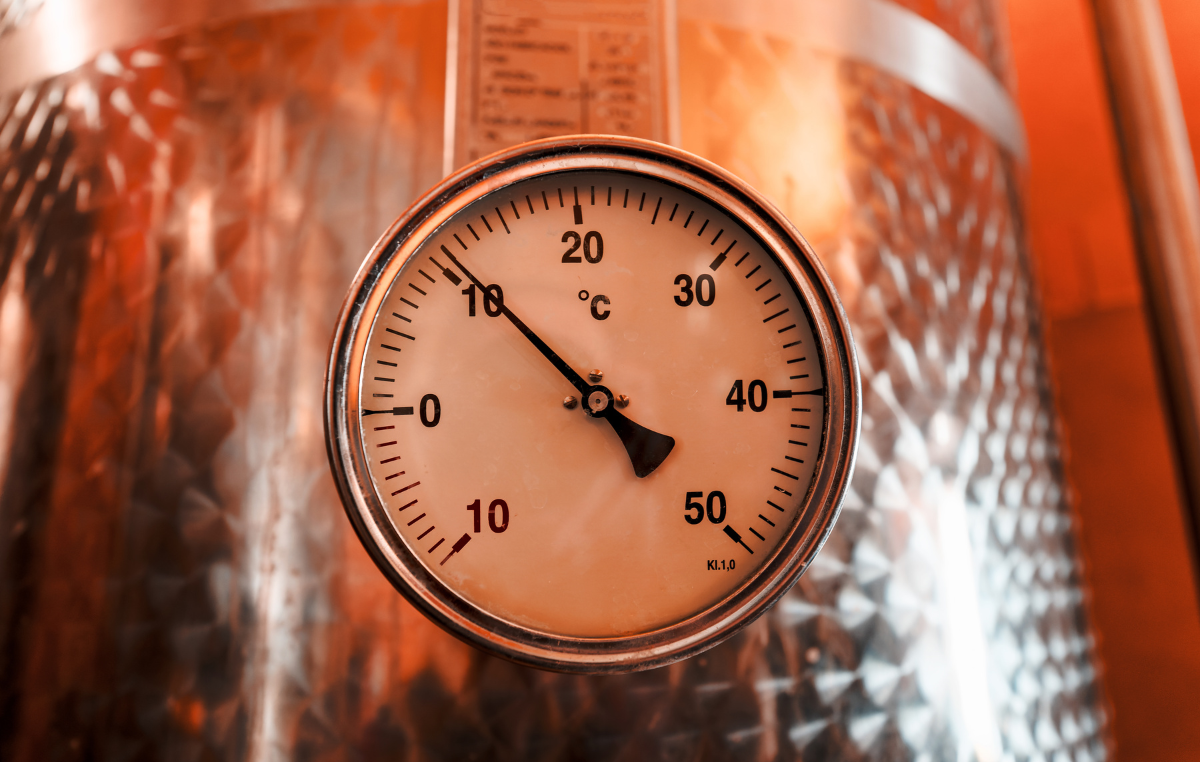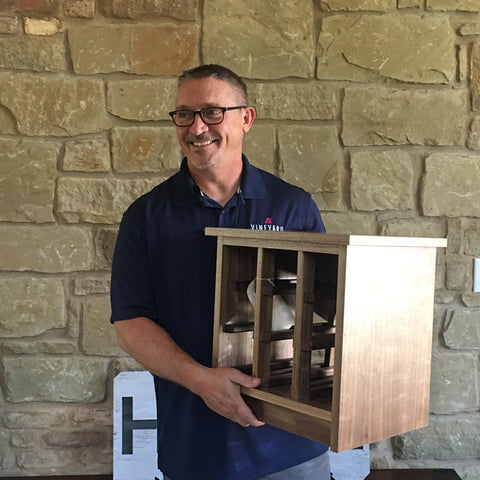If you're like us and love your wine collection, you know how important it is to store your bottles just right.
In this blog, we'll go over a handy Wine Storage Temperature Chart to help you preserve your collection. Trust us, getting this right can make a world of difference in taste and quality!
The Impact of Temperature on Wine

Chemical Reactions Inside the Bottle
Wine may seem simple, but a fascinating dance of chemical reactions constantly occurs inside the bottle. These reactions give wine unique aromas, flavors, and overall character. Temperature acts as a conductor in this symphony, influencing the rate and intensity of these reactions.
The Sweet Spot: Ideal Temperature for Wine Storage
Every wine has a sweet spot, an optimal temperature range that optimizes these chemical reactions. Storing your bottle of wine at the proper temperature ensures it tastes its best when you finally uncork it.
Havoc of Heat
- Exposure to Excessive Heat: When wine bottles are exposed to excessive heat, the chemical reactions inside accelerate dramatically. This can lead to a phenomenon known as "cooked wine." The flavors become muted and unpleasant. Delicate aromas are lost, and the overall taste profile becomes flat and uninteresting.
Crippling Cold
- Excessively Cold Temperatures: Freezing temperatures can have the opposite effect. The chemical reactions slow down significantly, hindering the wine's development. This can result in a wine that tastes underdeveloped, lacking the complexity and nuance it should possess. That’s why the right temperature matters.
Consistency: Maintaining Stable Temperatures
- Fluctuation: It's important to note that fluctuating temperatures can be as damaging as extreme ones. Constant swings between hot and cold can confuse the delicate chemical processes within the wine, leading to unpredictable and undesirable flavors.
- Wine Cellar or Fridge: Aim to maintain a consistent temperature in your wine cellar or fridge for optimal storage.
Wine Storage Temperature Chart: Guide to the Right Temperature
We've created a handy chart to help you choose the right wine storage temperature. This chart is organized by wine type and provides ideal storage and serving temperature ranges for reds, whites, sparkling wines, and more.
White Wines
White wines generally thrive in cooler temperatures than reds. Most white wines' ideal storage temperature range is between 45°F and 55°F.
- Impact of Proper Storage: Storing white wines at the right temperature allows them to retain their bright, refreshing qualities. You'll enjoy the vibrant fruit flavors, crisp acidity, and the overall balance the winemaker intended.
- Impact of Improper Storage: Hot temperatures can lead to a loss of acidity, making the wine taste flabby and dull. Conversely, storing white wines too cold can mute their aromas and flavors.
White Wines vs. Room Temperature: A Common Misconception
A common misconception is that all wines should be served at "room temperature." This may have been true for centuries, but with our modern climate-controlled homes (and climate change), "room temperature" can often be too warm for many white wines. Storing white wines at the ideal temperature range helps preserve their crisp acidity and delicate taste.
Examples: Pinot Grigio, Sauvignon Blanc, Chardonnay (unoaked)
Red Wines
Red wines generally prefer slightly warmer temperatures than whites. This allows the tannins, which contribute to the wine's structure and mouthfeel to soften, resulting in a smoother and more enjoyable drinking experience. The fruit flavors and aromas will also come alive. The red wine storage temperature range for most red wines falls between 55°F and 65°F.
- Body and Regional Styles: While this range provides a good starting point, a few factors can influence the ideal storage temperature for your red wine:
- Body: Lighter-bodied reds, like those from some cooler wine regions such as Burgundy or Northern Italy, might benefit from slightly cooler storage (around 55-60°F) to maintain their refreshing qualities. Full-bodied reds from warmer regions like California or Australia may thrive at slightly higher temperatures (around 60-65°F).
- Age: Younger red wines can handle cooler temperatures, while mature wines may benefit from slightly warmer storage (around 60-65°F).
- Impact of Improper Storage: Sweltering temperatures can lead to "cooked wine" characteristics, with muted aromas and a flat taste. Conversely, storing red wines too cold can make the tannins feel harsh and astringent.
Examples: Cabernet Sauvignon, Merlot, Pinot Noir (lighter-bodied), Zinfandel
Wine Storage Temperature Chart
|
Wine Type |
Ideal Storage Temperature Range (Fahrenheit) |
Ideal Serving Temperature Range (Fahrenheit) |
|
Red Wine (light-bodied) |
55°F - 60°F |
58°F - 65°F |
|
Red Wine (full-bodied) |
58°F - 65°F |
60°F - 68°F |
|
White Wine (dry) |
45°F - 55°F |
48°F - 55°F |
|
White Wine (sweet) |
42°F - 48°F |
45°F - 50°F |
|
Rosé Wine |
48°F - 55°F |
50°F - 55°F |
|
Sparkling Wine |
45°F - 50°F |
43°F - 47°F |
|
Dessert Wine |
42°F - 48°F |
50°F - 55°F (depending on style) |
3 Essential Wine Storage Tips
The correct temperature is just one piece of the puzzle regarding optimum wine storage. Here are some additional factors to consider for a genuinely thriving wine collection, including short-term storage for wines you plan to enjoy soon:
- Keep it Dark: Light exposure, particularly direct sunlight, can trigger unwanted chemical reactions in wine, leading to off-flavors and premature aging. The best practice is to store your wines in a cool, dark space or invest in wine racks or cabinets with UV protection, or dedicated wine fridge or cooler.
- Humidity Control: Ideal humidity levels for wine storage fall between 50% and 70%. Excessively dry conditions can cause corks to shrink and dry out, allowing air to enter the bottle and spoiling the wine. Conversely, too much humidity can encourage mold growth.
- Minimize Movement: Constant vibration can disrupt the delicate chemical reactions inside the fine wine bottle. Aim for a stable storage area with minimal movement or jostling for best results.
Types of Wine Storage Solutions
Finding the proper storage solution depends on your space, budget, and collection size. Here's a quick overview of some popular options:
- Wine Cellars: A dedicated wine cellar offers the ultimate environment for long-term wine storage. However, they require significant space and investment.
- Wine Refrigerators: Wine coolers have temperature controls, making them a fantastic option for those who lack the space for a dedicated wine room. Dual or three-temperature zone wine fridges offer different temperatures to accommodate various wine types in one place. At the same time, a single-zone refrigerator is best for storing one kind of wine.
- Cool, Dark Spaces: A cool, dark basement or closet that maintains consistent temperatures can be a suitable storage area for your wines. Just invest in proper racking to keep the bottles secure and organized.
- Wine Cabinets: Stylish and functional, wine cabinets offer a great way to store and display your favorite bottles. They're a perfect solution for everyday wines you plan to enjoy soon.
Takeaway
By understanding the importance of proper wine storage and following this guide, you can ensure your cherished wines keep their quality for a long time. The provided wine storage temperature chart serves as a valuable tool, offering a starting point for different types of wine. With this knowledge and the proper storage solutions, you can confidently safeguard your wine collection, guaranteeing a gratifying experience with every sip.
At what temperature do you store your wine?
FAQs

Is a regular refrigerator too cold to store wine?
Yes. A refrigerator can be too cold for long-term wine storage. Most refrigerators are colder than the ideal temperature range for most wines, typically below 55°F. Invest in a wine fridge or wine cooler for proper wine storage.
What is the lowest temperature at which wine can be stored?
Wine can technically be stored at very cold temperatures, but it can negatively impact the taste and aroma. The ideal storage temperature depends on the specific wine type. Download our chart for your reference.
What temperature destroys wine?
Extremely high temperatures can damage wine. Generally, storing wine above 70°F for extended periods is not recommended, as it can accelerate spoilage.
Is it okay to store wine in the garage?
Garages are not suitable for wine storage because of temperature fluctuations and potential light exposure, which can harm the quality of your wine.


